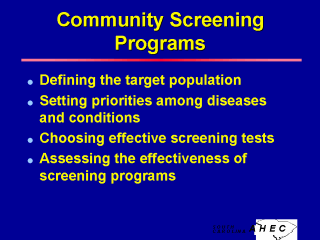| front |1 |2 |3 |4 |5 |6 |7 |8 |9 |10 |11 |12 |13 |14 |15 |16 |17 |18 |19 |20 |21 |22 |23 |24 |25 |26 |27 |28 |29 |30 |31 |32 |33 |34 |35 |36 |37 |38 |39 |40 |review |
 |
Epidemiologic principles are central to the major operational tasks required to develop and implement organized screening programs in the community. - Defining the target population for a screening program involves describing the settings and the characteristics of the populations who would be eligible for screening. Important concepts include community, settings, mass versus selective screening, risk stratification, and high-risk versus population strategies. - After identifying a particular population in need of intervention, organizers must decide what health conditions or diseases should be given priority for new or expanded efforts. Potential criteria for ranking include disease burden, availability of effective screening test(s); availability of effective treatment and follow-up; and cost-effectiveness. - An effective screening program depends upon the availability of a screening test that is reliable, accurate, acceptable to participants, and affordable in relation to its benefits. Important epidemiologic concepts that relate to the accuracy of a screening procedure are sensitivity, specificity, predictive value, and lead time. - The effectiveness of a screening program is determined by measuring the changes in health outcomes attributable to the program. Important concepts include efficacy versus effectiveness, study design, prevented fraction, cost-effectiveness and cost-benefit. |
| front |1 |2 |3 |4 |5 |6 |7 |8 |9 |10 |11 |12 |13 |14 |15 |16 |17 |18 |19 |20 |21 |22 |23 |24 |25 |26 |27 |28 |29 |30 |31 |32 |33 |34 |35 |36 |37 |38 |39 |40 |review |